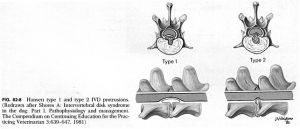Dachshunds are the number one breed to suffer from intervertebral disc problems. The intervertebral discs are located beneath the spinal cord, in between each vertebra, and are like jelly doughnuts. Each has an outer fibrous layer, like the crust portion of the doughnut, and an inner nucleus pulposus, like the jelly portion. Dachshunds and other breeds like Beagles, Pekingese, Cocker Spaniels can develop mineralization of their discs, which causes the nucleus pulpous (jelly portion of the doughnut, remember) to become like bone, which makes it more predisposed to rupturing.

When the disc ruptures, the nucleus portion of the disc causes compression on the spinal cord. The most common place for rupture is at the thoracolumbar junction or mid-back. It can also occur in the neck, but this article will not address this location. Depending on how compressed the spinal cord is directly correlates to the severity of the clinical signs. Pain is the first sign, which can progress to complete paralysis (loss of all movement in limbs) and loss of deep pain (unable to feel and recognize a painful stimulus to the limb). Prognosis for recovery depends on how severe the clinical signs are and what treatment option is pursued; each case is different. Surgery is most commonly recommended to remove the disc from around the spinal cord if the signs are worse than just walking wobbly, which is called ataxia.
Prognosis for complete recovery with surgery is 85-90% as long as the dog still has deep pain sensation. It is best to not wait until the dog is completely paralyzed, but as long as deep pain is still intact, the prognosis is good with surgical intervention. Once deep pain is lost, there is a 50:50 chance of walking again if surgery is pursued soon after injury.
Rehabilitation with underwater treadmill therapy is the mainstay of recovery after back surgery. Different MedVet hospitals have a CT scanner available for imaging the exact location of the ruptured disc prior to surgery. In some cases myelogram may also need to be done, which injects contrast material around the spinal cord to highlight the ruptured disc.

